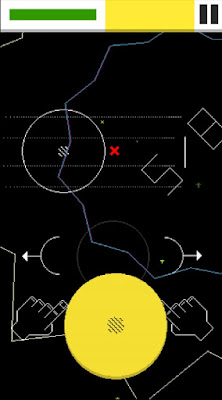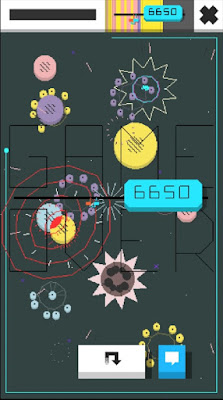Touch-sensitive devices, usually mobile phones, are one thing, but devices capable of accepting and keeping track of multiple touch inputs are another beast entirely. From point and click to drag and drop, and now pinch to zoom and beyond, the multitouch accessibility of iOS devices, and the explosion of mobile gaming on them, lead to quite a few possibilities for developers to explore.
One man took multitouch and ran with it, creating the graphically stylish puzzler known as Eliss, a game that only a mobile device could allow.
Oh...
Frustrations
I don't have an iOS device, and when I did have one, I didn't know Eliss was a game worth having, so I've never come across it anywhere. It would take 5 years before an Android version was released, featuring some new game modes, but that release doesn't seem to exist on the Play Store as of 2021, with the website also only being accessible via the Wayback machine.
Things were not looking too good, but luckily for us, the Internet exists, and the Internet likes to find ways around problems: Bluestacks Android emulator and some side-loaded .apk files...
I was hopeful that I could get at least some sense of what was going on in Eliss through emulation, but I have one touch input device on this PC, and that's my mouse pretending to be a finger. For dragging small stars together to make them big enough to trigger their removal from the arena by plopping them onto the target, a mouse was fine. To pull a giant star apart so that it splits into two smaller stars... that was tricky.
Unfortunately, my final test was to juggle four different stars as they were slowly sucked into a black hole of sorts, but juggling them in such a way as to not collide with each other, else they got smaller and I would lose level health, for want of a better term. Oh, and I had to keep them moving away from the black hole until their target destinations appeared and finished forming so that I could actually get rid of the damn things.
It wasn't looking good. The idea is to use four fingers here. I had one, and it was a mouse.
Fun Times
After a couple of attempts, though, it was done. By luck or by skill, the tutorial was complete, and Eliss was open to me, firstly in an infinite mode, which was introduced in the Android release.
Eliss is not a game that you can grasp from screenshots. If you can, view it in motion and try to work out what's going on. In random locations on the screen, a coloured circle will appear, just yellow and red to begin with, but soon joined by blue and purple to give you more problems to deal with.
If left alone they'll happily sit still, but you can fling them across the screen or drag and drop them into place. Drag two like-coloured circles together and they'll merge into one bigger circle, which is important for meeting the size requirements for the target - too big or too small and your stars or circles or whatever they are won't disappear, won't score points, and won't be removed from the screen to give you some extra space to work with. Getting it just right is the aim of the game.
Unfortunately, with an awful lot to deal with, and even more spawning in against my wishes, my first run of Eliss would soon come to an end. Stars were trying to appear where other stars already were, and if they're of different colours, the screen flashes red to indicate a problem, and the stars involved start shrinking, else start depleting your health bar, which doesn't really relate to anything specific in-game, other than telling you "you've had enough chances, it's actually game over now".
My second run was better, I was getting used to some kind of strategy, naming moving things out of the way and leaving them alone until I needed to deal with them, and smoothing smaller problems together to keep my workspace clear.
It wasn't much more of an improvement. I don't know how I got a nice fat 2000 point bonus, either, but it was enough to push me over the threshold for an unlock of some sort, which turned out to be the puzzle mode I assume was the original Eliss.
Incidentally, I picked up a power-up at the end of that game to slow everything down and make my life easier. I guess I needed it slowed down an awful lot more to avoid the Game Over that was looming nearby, but hey, I'm learning - and am still only using a mouse.
Paired with this art style, Eliss certainly stands out from the other games that were slapped together and thrown onto the iOS store to make a quick buck. The menus may even be too simplistic to easily navigate. They're arty, more than accessible.
This red thing roamed wherever it wanted and gently nudged whatever was nearby, but it didn't really impact me in any meaningful way. I'm sure it'll turn out to be an absolute nightmare if I was in more of a cramped space, or it moved faster.
Final Word
You can certainly have a good time with Eliss via emulation, but it really is a game that is designed to make full use of multiple touch inputs. As the minimalist graphics made note of at the start of the game, it's one where you ought to play with your device on a table, and both hands working together. You just can't get that with a keyboard and mouse.
I don't know why I can't find it on the Android store at all. I hope it's not lost for good, or locked away on iOS once more, because Eliss is something that stands out in many ways. It looks like little else, especially on mobile, and plays like nothing else too.
Someone was going to make a multi-touch input game, and someone was going to do it well, and that it came in the form of Eliss from a one-man development team makes it all the more impressive. If it ever does come into your view, give it some thought. Well worth playing around with, this.
Fun Facts
Planets and squeesars, you say? Not circles and stars and targets and stuff?
Eliss, developed by Steph Thirion, first released in 2009.
Version played: Eliss Infinity, Android, 2014, via emulation.
























